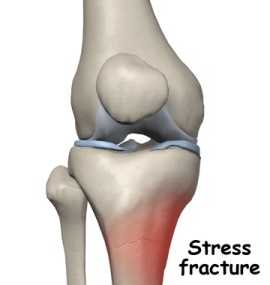Do you require any assistance? Simply reserve your appointment online below
Stress Fracture
Center for advanced orthopedics
Stress fractures
One of the most common injuries in sports is a stress fracture. Overcoming an injury like a stress fracture can be difficult, but it can be done.
A stress fracture is an overuse injury. It occurs when muscles become fatigued and are unable to absorb added shock. Eventually, the fatigued muscle transfers the overload of stress to the bone causing a tiny crack called a stress fracture.
The weight-bearing bones of the foot and lower leg are especially vulnerable to stress fractures.

Causes of stress fractures

Stress fractures often are the result of increasing the amount or intensity of an activity too rapidly.
They also can be caused by the impact of an unfamiliar surface (a tennis player who has switched surfaces from a soft clay court to a hard court); improper equipment (a runner using worn or less flexible shoes); and increased physical stress (a basketball player who has had a substantial increase in playing time).
Most stress fractures occur in the weight bearing bones of the lower leg and the foot. More than 50 percent of all stress fractures occur in the lower leg.
Population at Risk of having stress fractures
Stress fractures affect people of all ages who participate in repetitive sporting activities, like running.
Medical studies have shown that female athletes seem to experience more stress fractures than their male counterparts.
Many orthopaedic surgeons attribute this to a condition referred to as “the female athlete triad”: eating disorders (bulimia or anorexia), amenorrhea (infrequent menstrual cycle), and osteoporosis.
As a female’s bone mass decreases, her chances of getting a stress fracture increase.
Diagnosing Stress fractures
It is very important that during the medical examination the doctor evaluates the patient’s risk factors for stress fracture.
X-rays are commonly used to determine stress fracture. Sometimes, the stress fracture cannot be seen on regular x-rays or will not show up for several weeks after the pain starts.
Occasionally, a computed topography (CT) scan or magnetic resonance imaging (MRI) will be necessary.

You are in Great Hands
Treatment of Stress fractures

The most important treatment is rest. Individuals need to rest from the activity that caused the stress fracture, and engage in a pain-free activity during the six to eight weeks it takes most stress fractures to heal.
If the activity that caused the stress fracture is resumed too quickly, larger, harder-to-heal stress fractures can develop. Re-injury also could lead to chronic problems where the stress fracture might never heal properly.
In addition to rest, shoe inserts or braces may be used to help these injuries heal.
Surgical treatment
Some stress fractures require surgery to heal properly. In most cases, this involves supporting the bones by inserting a type of fastener. This is called internal fixation.
Pins, screws, and/or plates are most often used to hold the small bones of the foot and ankle together during the healing process.

Prevention of stress fractures
- When participating in any new sports activity, set incremental goals. For example, do not immediately set out to run five miles a day; instead, gradually build up your mileage on a weekly basis.
- Cross-training — alternating activities that accomplish the same fitness goals — can help to prevent injuries like stress fractures. Instead of running every day to meet cardiovascular goals, run on even days and bike on odd days. Add some strength training and flexibility exercises to the mix for the most benefit.
